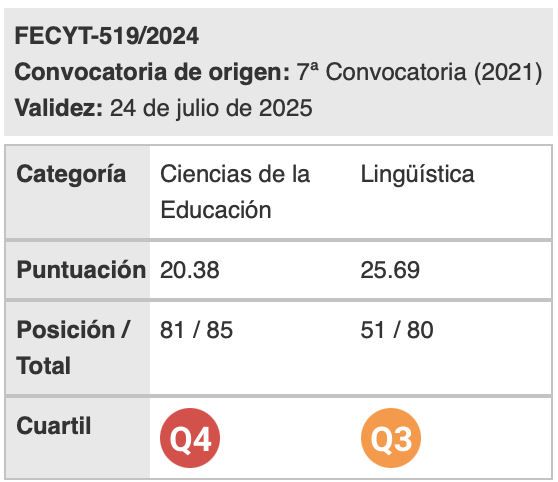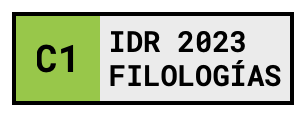La producción lingüística en el aprendizaje de inglés como lengua extranjera: el metalenguaje
Palabras clave:
output, foreign language learning, feedback, metalanguageResumen
This case study presents evidence of the different ways in which metalanguage can appear in the foreign language (FL) classroom and of the benefits that interactions including reflection upon language can provide to language learning in a group of 4o ESO students. The roles played by output and metalanguage in the second language (L2) learning process has been examined by many studies (Gass and Mackey, 2007; Lyster and Ranta, 1997; Lyster & Saito, 2010; Swain, 1995, 2000; Swain and Lapkin, 1998). The data presented here correspond to an analysis of the language related episodes (LRE) found in the big group and the small group interactions that took place in the 21 sessions observed. To solve their linguistic problems, students resorted to both their mother tongue (L1) and the FL with the aim of completing the assigned task. The episodes collected show how the use of language activates certain mental processes and consequently represents an occasion for learning. The results obtained confirm the benefits of increasing the frequency with which students use the FL in class.
Descargas
Citas
Arnaiz Castro, P. y Peñate Cabrera, M. (2004). El papel de la producción oral (output) en el proceso de aprendizaje de una lengua extranjera (LE). Porta Linguarum, 1, 37-60.
Basturkmen, H., Loewen, S. y Ellis, R. (2002). Metalanguage in focus on form in the communicative classroom. Language Awareness, 11, 1-13.
Common European Framework of Reference for Languages: Learning, Teaching, Assessment (2001). Strasbourg: Council of Europe.
De Guerrero, M. C. M. y Villamil, O. (2000). Activating the ZPD: Mutual scaffolding in L2 peer revision. The Modern Language, 84 (I), 51-68.
Donato, R. y Adair-Hauck, B. (1992). Discourse perspectives on formal ins- truction. Language Awarenes, 1(2), 73-89.
Ellis, R., Loewen, S. y Erlam, R. (2006). Implicit and explicit corrective feed- back and the acquisition of L2 grammar. Studies in Second Language Acquisition, 28, 339-368.
García Mayo, M. P. y Alcón Soler, A. (2002). Strategies in rendering gramma- ticality judgements in L1 and L2. En L. Iglesias Rábade & S. Doval Suárez (Eds.), Proceedings of the II International Contrastive Linguistics Conference (pp. 445- 453). Santiago de Compostela: Universidad de Santiago de Compostela.
Gass, S. (1997). Input, Interaction and the Second Language Learner. Hillsdale, NJ: Lawrence Erlbaum Associates.
Gass, S. y Mackey, A. (2000). Stimulated recall methodology in second language rese- arch. New Jersey: Lawrence Erlbaum Associates.
Gass, S. y Varonis, E. (1994). Input, interaction and second language produc- tion. Studies in Second Language Acquisition, 16, 283-302.
Gombert, J. (1990). Le devéloppement métalinguistique. Paris: PUF.
Goetz, J. P. y Lecompte, M. D. (1988) [1984]. Etnografía y Diseño Cualitativo en
Investigación Educativa. Madrid: Morata.
Karmiloff-Smith, A. (1992). Beyond Modularity. A Developmental Perspective on Cog-
nitive Science. London: MIT Press.
Klippel, F. (1984) [1983]. Keep talking. Cambridge: Cambridge University Press.
Kowal, M. y Swain, M. (1994). Using collaborative language production tasks to promote students’ language awareness. Language Awareness, 3(2), 73-93.
Kowal, M. y Swain, M. (1997). From semantic to syntactic processing: How can we promote metalinguistic awareness in the French immersion classro- om. En R. K. Johnson & M. Swain (Eds.), Immersion Education: International perspectives (pp. 284-309). Cambridge: CUP.
Lázaro Ibarrola, A. (2009). Reformulation and self-correction: testing the vali- dity of correction strategies in the classroom. RESLA, 22, 189-215.
Leeser, M. J. (2004). Learner proficiency and focus on form during collaborative dialogue. Language Teaching Research, 8, 55-81.
Leow, R. P. (1997). Attention, awareness and foreign language behaviour. Lan-
guage Learning, 47, 467-506.
Lyster, R. (2004). Differential effects of prompts and recasts in form-focused
instruction. Studies in Second Language Acquisition, 19, 399- 432.
Lyster, R. y Ranta L. (1997). Corrective feedback and learner uptake: negotia- tion of forms in communicative classrooms. Studies in Second Language Acquisition, 19, 37-66.
Lyster, R. y Saito, K. (2010). Oral feedback in classroom SLA. A meta-analysis. Studies in Second Language Acquisition, 32, 265-302.
McLaughlin, B. (1990). Restructuring. Applied Linguistics, 11(2), 113-128. Nunan, D. (1991). Methods in second language classroom-oriented research.
Studies in Second Language Acquisition, 13, 249-274.
Philp, J. (2003). Constraints on “noticing the gap”: Non-native speakers’ noti- cing of recasts in NS-NNS interaction. Studies in Second Language Acquisition, 25, 99-126.
Robinson, P. (1997). Individual differences and the fundamental similarity of implicit and explicit adult second language learning. Language Learning 47, 45-99.
Rosa, E. M. y Leow, R. P. (2004). Awareness, different learning conditions and second language development. Applied Psycholinguistics, 25, 269-292.
Russell, J. y Spada, N. (2006). The effectiveness of corrective feedback for second language acquisition: A meta-analysis of the research. En J. Norris & L. Ortega (Eds.), Synthesizing research on language learning and teaching (pp. 133- 164). Amsterdam: Benjamins.
Rutherford, W. E. y Sharwood Smith, M. S. (1985). Consciousness-raising and universal grammar. Applied Linguistics, 6(3), 274-282.
Schmidt, R. (1990). The role of consciousness in second language learning. Applied Linguistics 11, 129-158.
Shaffer, C. (1989). A comparison of inductive and deductive approaches to teaching foreign languages”. The Modern Language Journal, 73(4), 395-403.
Simard, D. y Jean, G. (2011). An Exploration of L2 Teachers’ Use of Pedagogical Interventions Devised to Draw L2 Learners’ Attention to Form. Language Learning, 61 (3), 759-785.
Spada, N. y Lightbown, P. M. (2009). Interaction in second/foreign language classrooms. En A. Mackey & C. Polio (Eds.), Multiple perspectives on interaction: Second language research in honor of Susan M. Gass (pp. 157-174). London: Rou- tledge.
Storch, N. (2001). How collaborative is pair work? ESL tertiary students compo- sing in pairs. Language Teaching Research, 5, 29-53.
Swain, M. (1985). Communicative competence: some roles of comprehensible input and comprehensible output in its development. En T. Gass and C. Madden (Eds.), Input in second language interaction (pp. 235-253). Rowley: MA. Newbury House.
Swain, M. (1993). The output hypothesis: just speaking and writing are not enough. Canadian Modern Language Review, 50, 158-164.
Swain, M. (1995). Three functions of output in second language learning. En G. Cook & B. Seidlhofer (Eds.), Principle and practice in applied linguistics (pp. 125-144). Oxford: Oxford University Press.
Swain, M. (1998). Focus on form through conscious reflection. En C. Doughty & J. Williams (Eds.), Focus on form in classroom second language acquisition (pp. 64- 81). Cambridge: Cambridge University Press.
Swain, M. (2000). The output hypothesis and beyond: Mediation acquisition through collaborative dialogue. En J. P. Lantolf (Ed.), Sociocultural theory and second language learning (pp. 97-114). Oxford: Oxford University Press.
Swain, M. (2005). The output hypothesis: theory and research. En E. Hinkel (Ed.), Handbook of research in second language learning and teaching (pp. 471-484). Mahwah, NJ: Erlbaum.
Swain, M. (2006). Languaging, agency and collaboration in advanced second language proficiency. En H. Byrnes (Ed.), Advanced language learning: the contributions of Halliday and Vygotsky (pp. 95-108). London: Continuum.
Swain, M. y Lapkin, S. (1998). Interaction and second language learning: two adolescent French immersion students working together. The Modern Language Journal, 82(3), 320-337.
Swain, M., Brooks, L. y Tocalli-Beller, A. (2002). Peer-peer dialogue as means of second language learning. Annual Review of Applied Linguistics, 22, 171-85.
Tomasello, M. y Herron, C. (1989). Feedback for language transfer errors: the garden path technique. Studies in Second Language Acquisition, 11(4), 385-395.
Valcárcel Pérez, M. S. y Verdú Jorda, M. (1995). Observación y Evaluación de la Enseñanza Comunicativa de Lenguas Modernas. Madrid: MEC/CIDE.
Vygotsky, L. S. (1986) [1934]. Thought and Language. Cambridge, Mass.: MIT Press.
Watanabe, Y. y Swain, M. (2007). Effects of proficiency differences and pat- terns of pair interaction on second language learning: collaborative dialogue between adult ESL learners. Language Teaching Research, 11(2), 121-142.
Williams, J. (2001). The effectiveness of spontaneous attention to form. System, 29, 325-340.
Yang, Y. y Lyster, R. (2010). Effects of form-focused practice and feedback on Chinese EFL learners’ acquisition of regular and irregular past tense forms. Studies in Second Language Acquisition, 32, 235-263.
Descargas
Publicado
Cómo citar
Número
Sección
Licencia
Aquellos autores/as que tengan publicaciones con esta revista, aceptan los términos siguientes:
- Los autores/as conservarán sus derechos de autor y garantizarán a la revista el derecho de primera publicación de su obra, el cuál estará simultáneamente sujeto a la Licencia de reconocimiento de Creative Commons que permite a terceros compartir la obra siempre que se indique su autor y su primera publicación esta revista.
- Los autores/as podrán adoptar otros acuerdos de licencia no exclusiva de distribución de la versión de la obra publicada (p. ej.: depositarla en un archivo telemático institucional o publicarla en un volumen monográfico) siempre que se indique la publicación inicial en esta revista.
- Se permite y recomienda a los autores/as difundir su obra a través de Internet (p. ej.: en archivos telemáticos institucionales o en su página web) antes y durante el proceso de envío, lo cual puede producir intercambios interesantes y aumentar las citas de la obra publicada. (Véase El efecto del acceso abierto).

Revista de Lenguas para fines específicos is licensed under a Creative Commons Reconocimiento-NoComercial-SinObraDerivada 4.0 Internacional License.






















